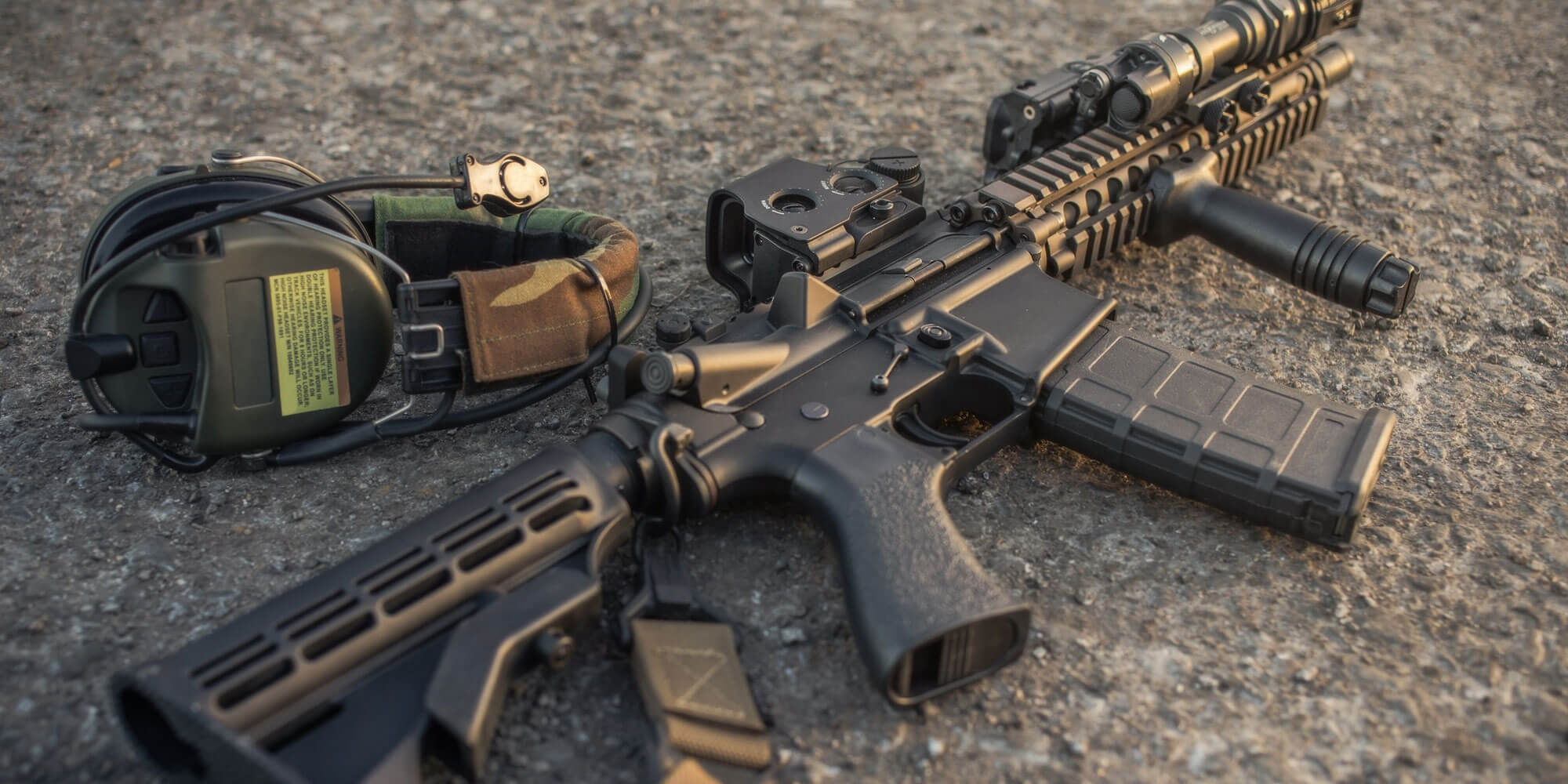Best AR-15 Round-Up: Our Suggestions
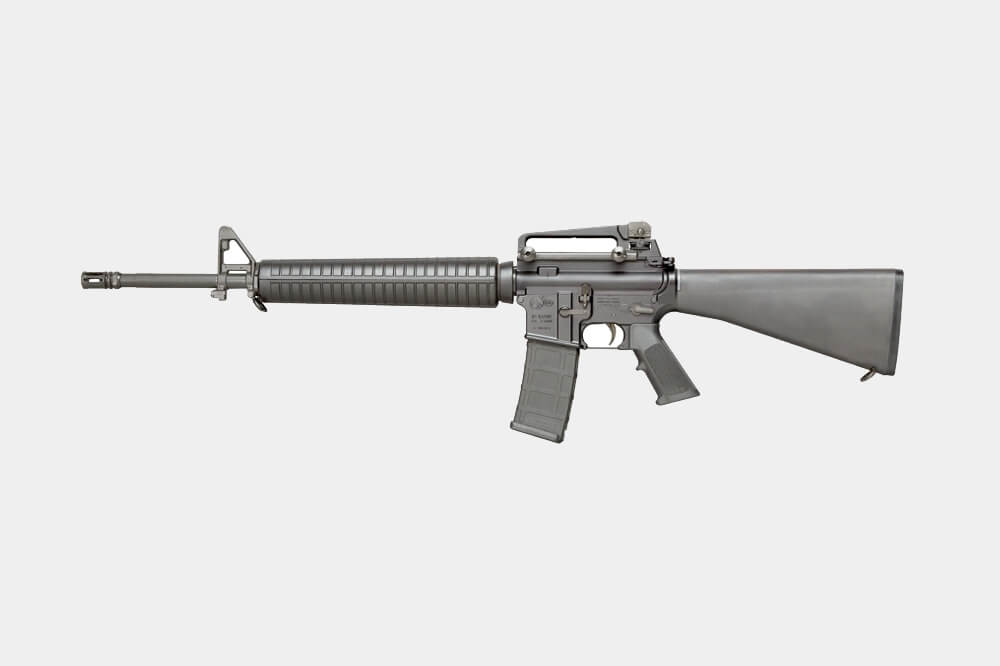 Colt AR15A4
Colt AR15A4
This AR-15 was first introduced in 2013 by Colt, a manufacturer known and trusted by the U.S. Military. This rifle carries a 20-inch barrel with a 1:7 twist rate, which helps it shoot with both speed and precision. The chrome lined 4150 CMV barrel will withstand wear and tear from moderate and heavy use. It also holds a DI gas system, single stage trigger, and ambidextrous safety, which makes this a great choice for 3-Gun. This rifle includes a stock detachable carry handle as well. This rifle is crisp and classic by design and looks great with most modifications.
Both the lower and upper receiver are made from hard anodized aluminum and a black hardcoat. This government rifle is definitely a blast from the past, and a beautiful one at that!
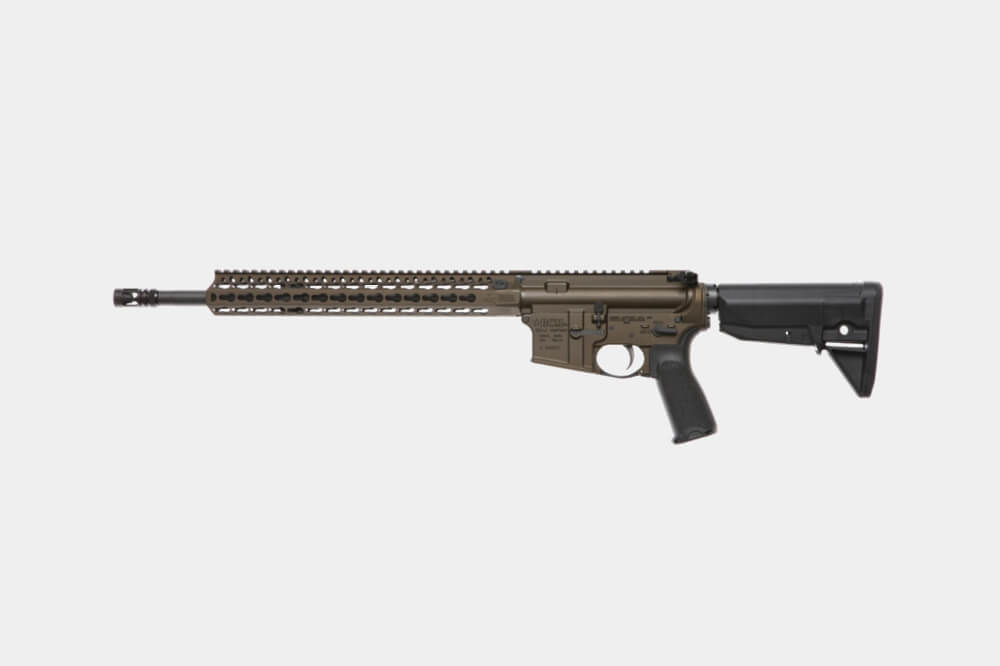 BCM® RECCE-16 KMR-A Carbine (Dark Bronze)
BCM® RECCE-16 KMR-A Carbine (Dark Bronze)
This 5.56 x 45mm NATO caliber rifle sports a 16-inch barrel made from 11595E chrome-lined certified steel, as well as a mid-length gas system and USGI profile. At just a little over six pounds, the rifle is both High Pressure Tested and Magnetic Particle Inspected. The gun also has an M4 Feed Ramp Barrel Extension and sports a government profile. The upper and lower receiver are both forged from anodized aluminum and finished with an Cerakote Dark Bronze anodized hardcoat.
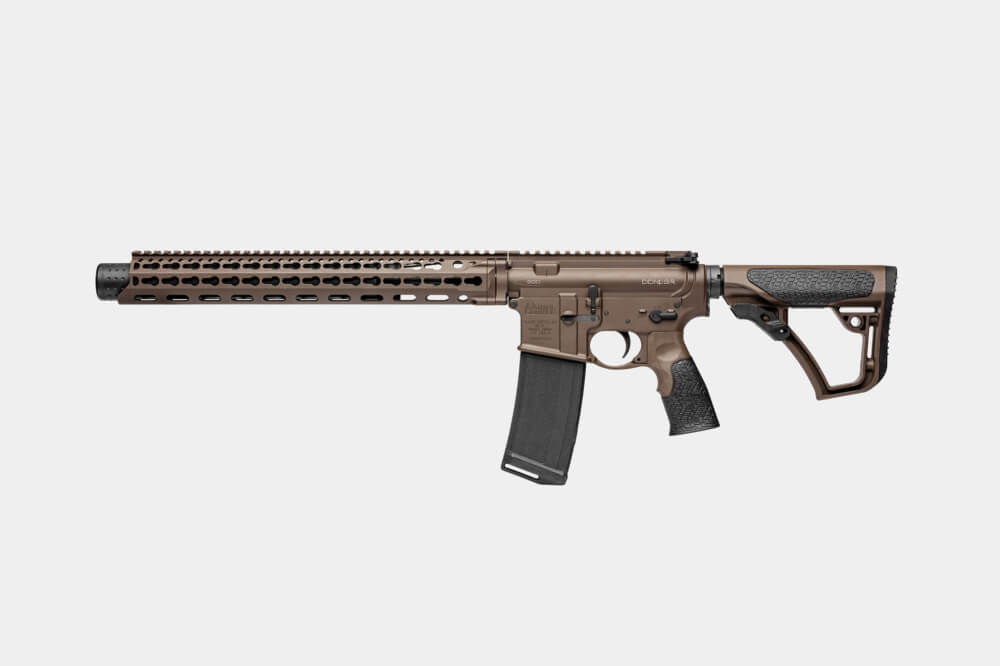 DDM4ISR (MIL SPEC)
DDM4ISR (MIL SPEC)
This 300 BLK caliber rifle, marketed as Daniel Defense’s “Integrally Suppressed Weapon System” sports only a 9” barrel that is cold hammer forged, fluted, and made from chrome-moly vanadium steel. The barrel also has a 1:8 twist rate. Don’t worry, though, because the integral suppressor extends the barrel to the legal length of 16 inches, so no special stamp is required. The rifle does, however, sport a direct impingement, pistol length gas system. It also sports the popular MFR XL 15.0 modular handguard with a 1913 Picatinny rail on top for mounting sights and optics, as well as additional keymod attachment points near the bottom and sides of the gun. The rifle has M4 feed ramps and an enhanced flared magazine. The upper and lower receivers are machine forged from aluminum with a Mil-Spec and Cerakote finish.
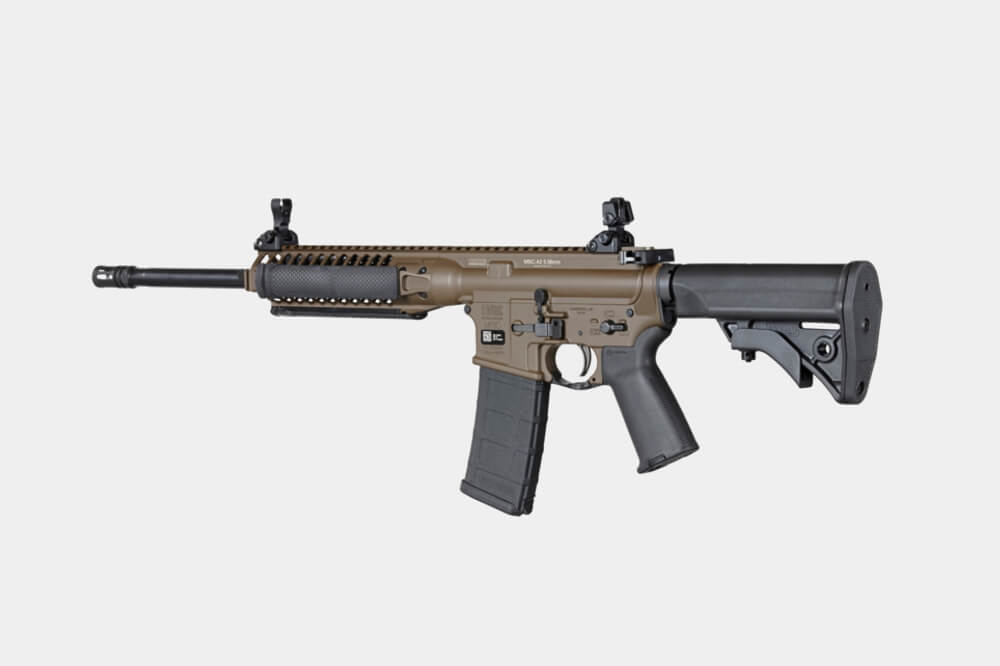 LWRC International IC-A2
LWRC International IC-A2
This gun has a NiCorr treated cold hammer forged barrel that is just over 16” and runs on a short stroke gas piston system. It features a 9 inch Quad Rail system for any and all necessary attachments. The rifle has an ambidextrous safety switch as well as an ambidextrous charging handle, and is built from heavy-duty steel alloys for extra durability. The 5.56 NATO caliber rifle has a 1:8 twist rate which provides stability and precision while shooting. The BCG is coated with Nickel Boron to reduce damage from heavy use, as well as corrosion and to help it stay lubricated longer. This rifle comes with the Skirmish iron sights, an adjustable stock, and an A2 Birdcage Flash Hider.
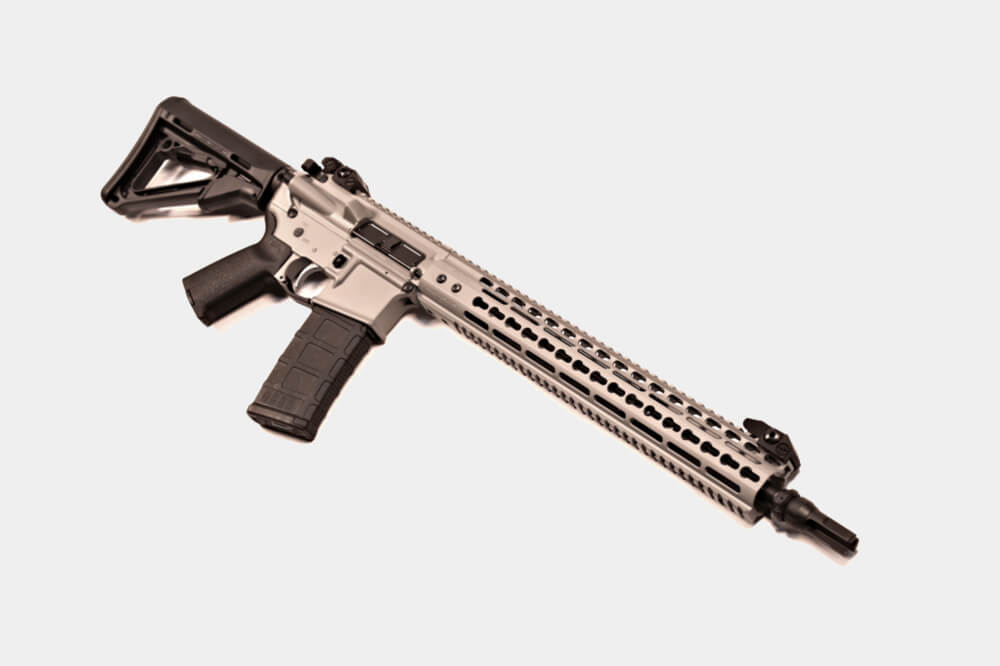 GEN I 16″ Chainsaw Rifle Smith’s Grey Cerakote
GEN I 16″ Chainsaw Rifle Smith’s Grey Cerakote
This expert rifle by Noveske features a 16-inch barrel that is cold hammer forged and chrome lined with a 1:7 twist rate, meaning you should get excellent precision when shooting. The low profile gas block is pinned to the barrel and leaves room for the NHR 15 inch free floating handguard with either Keymod or M-LOK attachment sites. The rifle features a Magpul CTR stock and Magpul MOE grip, Noveske Signature Back Up iron sights and comes with a 30 round magazine and a Dead Air Flash Hider. The upper and lower receiver are both coated with an anodized hard coat and a Smith’s Grey Cerakote coating.
Why Choose an AR-15?
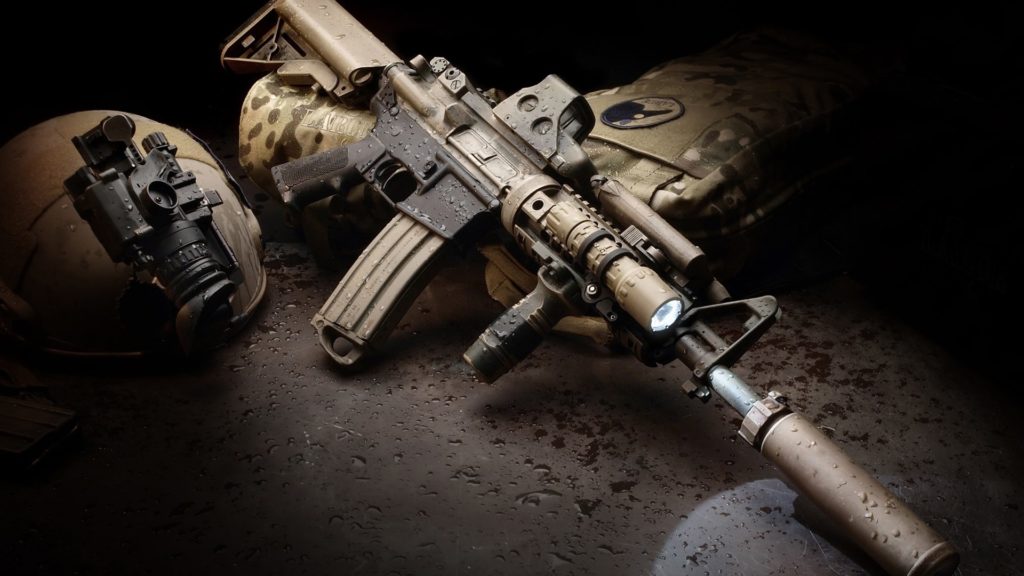
- The AR-15 provides a comfortable, ergonomic shooting experience. This rifle is incredibly lightweight and has a manageable recoil, which makes it easy to handle for most people, including women and children. The rifle’s design is similar to that of a popular military grade rifle, the M4, which should help assure you that it is built for comfort and long-term handling.
- This is a multipurpose rifle. By multipurpose, we mean it is great for ranged target shooting, home defense, tactical situations, as well as some types of hunting. It is not necessarily more powerful than other high caliber hunting rifles, so this debunks the myth that AR-15’s are “overpowered” and not great for hunting. They can even be used to hunt small animals, like rodents.
- Because the AR-15 is so popular, there are plenty of aftermarket parts floating around. If you choose to venture into it, you can easily customize your weapon. Many people even opt to build one from scratch, which gives them a fully customized experience. This means you can make a gun as light or heavy as you would like, optimize the precision and shooting accuracy, easily change sights and optics, or create a comfortable fit with different grips and handguards. You can also find custom designs for the exterior of your weapon, giving you a one of a kind gun to add to your collection.
- A version of the AR-15 is legal to own in all 50 states with appropriate background checks and licensing. It is not, in fact, an “Assault Weapon” and is often the top choice of people for home defense. Some states may require special licensing, but overall the AR-15 is completely legal.
- The AR-15 style rifle can be easily molded into an AR-15 pistol, which provides a powerful, ergonomic, and compact shooting experience. This can be more optimized for self-defense or can be used as an easy to carry hunting weapon. Please note that these pistol-style weapons require certain licensing and may be illegal in certain states.
Background on the AR-15
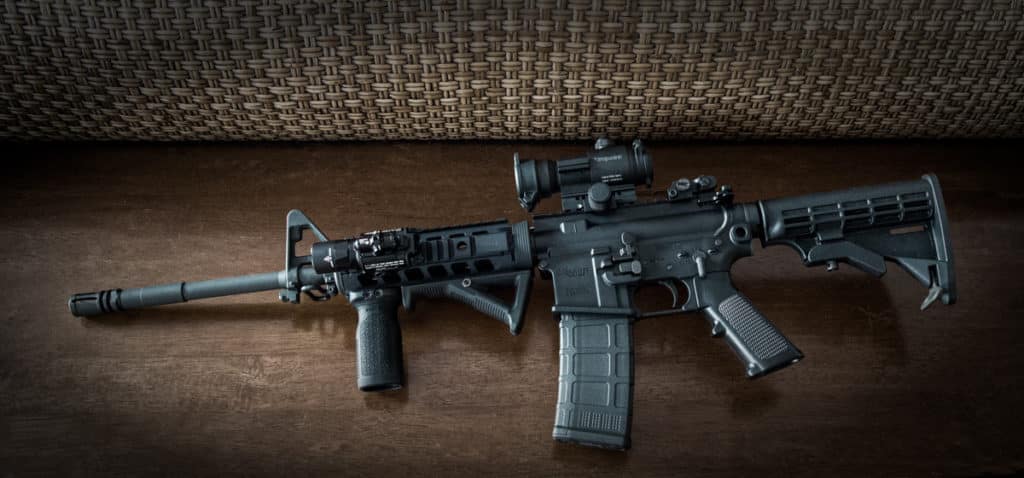
Colt did not give up on military acceptance, though, and eventually, after an impromptu shooting match with Air Force General Curtis LeMay at a picnic, the military reconsidered the powerful weapon. Slowly the AR-15 was incorporated into use by small sanctions of the U.S. Military, where it was categorized as “M16.” However, due to some slight friction during the military’s easy usage of the weapon, Colt opted to redesign it, adding a heavier barrel, forward bolt assist, and a different flash suppressor. After these changed, the U.S. military chose to formally adopt the AR-15, giving it the official military title, M16A1. Today, the M16 is one of the most heavily used rifles in the U.S. Military.
The AR-15 continued to develop and many rifles were inspired by it’s design. In 1977, Colt’s patent for the rifle’s design ran out, allowing other gun manufacturers to produce copies of the lightweight, semi-automatic weapon. Colt still holds the patent for the name, though, so these copies have different titles. Now, AR-15’s are marketed to civilians and law enforcement, while their twin, the M16, is mostly restricted to military use.
The name AR-15 stuck around from its original designers. Many people incorrectly believe that “AR” means “automatic rifle” or “assault rifle,” but it actually just stands for “Armalite.”
If You Want an AR-15, You Have Two Options
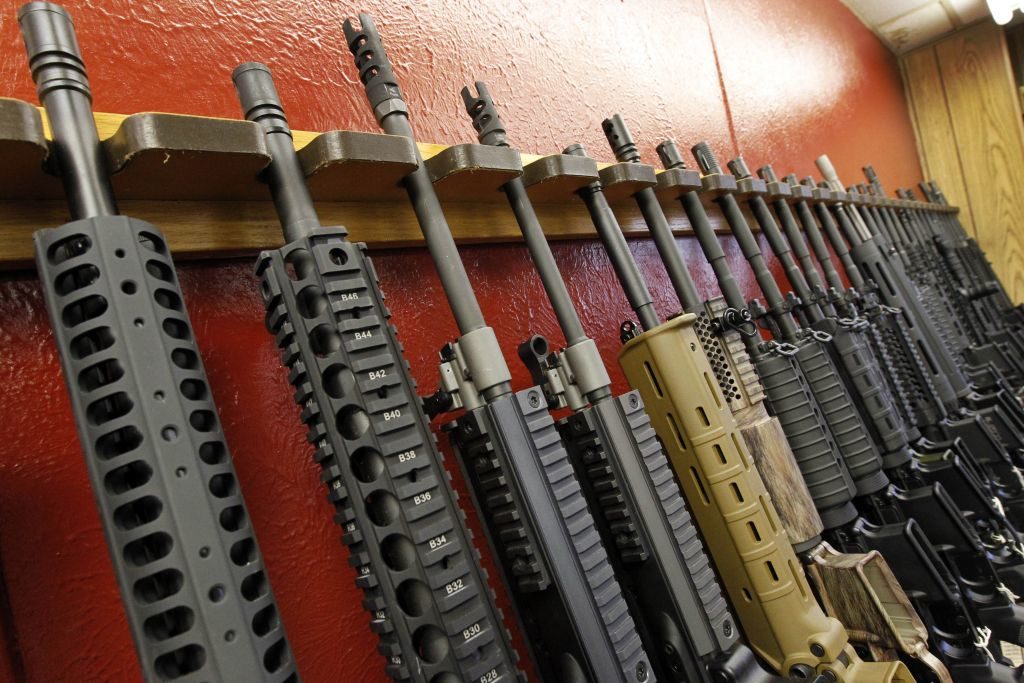
Are you going to buy it or build it? Building an AR-15 definitely has its appeal. You get a completely unique weapon, down to its hand-chosen hardware and custom color scheme. For a gun enthusiast, building a weapon is a pure delight. However, for those who aren’t so gun savvy, buying an AR-15 is probably the best bet.
Buying your AR-15 is generally much easier and typically cheaper, too. If you ever plan to part ways with your AR-15, you should know that factory rifles generally have a better resale value than custom rifles, too. While building an AR-15 definitely has its place, it’s not suggested if you have never owned this style of rifle before. Owning a factory made AR-15 first allows you the opportunity to get the know the rifle and all of its components, which will ensure you know what you want when you are hand picking parts for your gun. For this reason, it is suggested that you hand build your second AR-15, if you want to, of course.
If You’d Rather Build
If you plan to build an AR-15, you need to be familiar with all of its parts and pieces, and all of the alternative options you have to create a fully customized weapon. Building an AR-15 is pretty easy, you just have to know what you’re doing. You should know that there are two parts: the lower receiver and the upper receiver. You can build them both from scratch, or you can opt to buy one part and build the other yourself. It all depends on what you want out of your rifle. Let’s start with the basics:
Lower Receiver

As we said, the AR-15 is made up of two parts. The first of those parts, the lower receiver, is the part of the gun that contains the trigger, disconnector, fire selector, and hammer, which is known as the fire control group. The lower receiver must be marked with a serial number and bought through a licenses dealer. This part of the forearm contains many small parts. You can choose to buy each part individually and build a lower receiver yourself, or you can purchase a lower receiver and build the upper receiver to attach it to. Either way is fine.
Upper Receiver
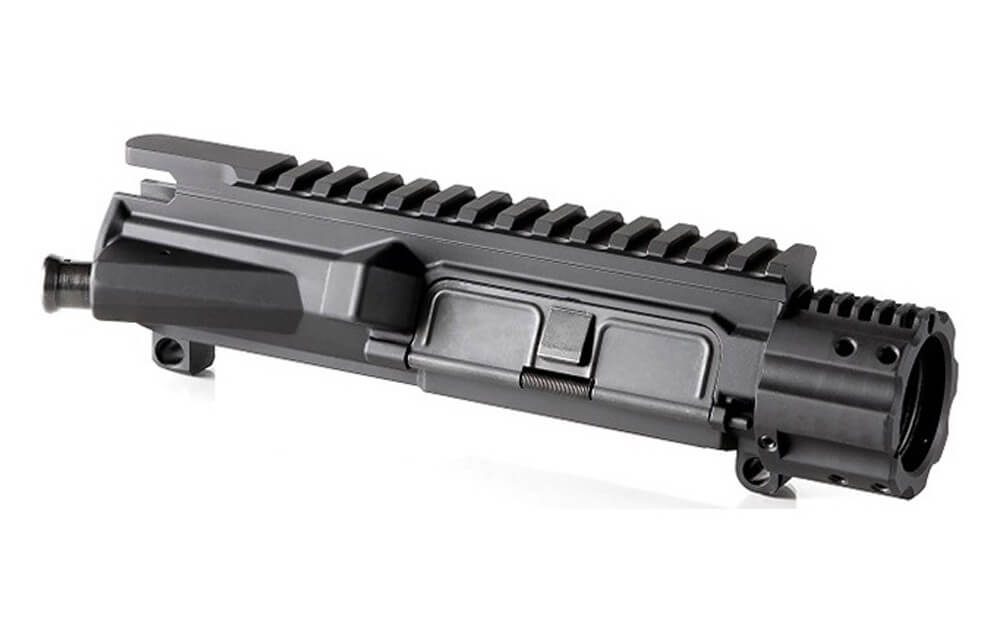
The upper receiver refers to all of the remaining parts of the main rifle. This is the most easily customized part of the gun and includes the charging handle, barrel, rail system, handguards, and more. The AR-15 is special due to its modular design of the upper receiver. Many people opt to buy the lower receiver and customize only the upper receiver in order to optimize their weapon to their personal standards.
Modular Design
Because the AR-15 is built and assembled in parts, it used a modular design structure, or the use or small modules to connect the gun parts. The concept is kind of like that of legos. The modular design is the reason that the gun is so easily customized, making it one of America’s favorite weapons.
Barrels
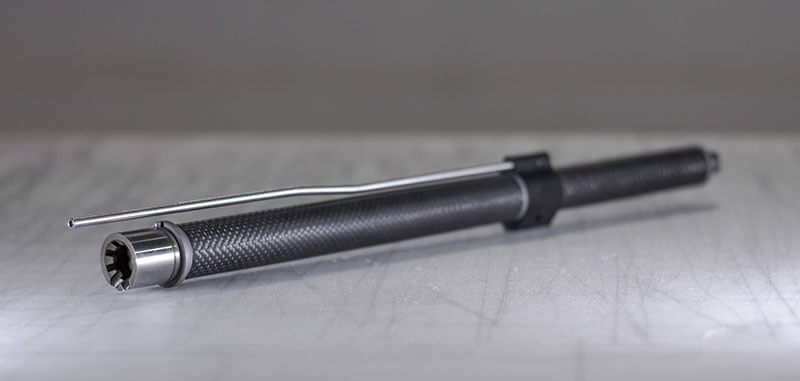
When choosing the right barrel for your weapon, you should understand all of the varying characteristics of aftermarket barrels. Barrels for the AR-15 are available in all sorts of materials, finishes, and lengths. Consider this:
Rifling
Rifling refers to the pattern of grooves in the inside of a rifle barrel. There are a few different rifling techniques used today, some of which are more popular than others. However, choosing a rifling technique is totally up to opinion, as there is no definitive evidence that one way is better than the next. Here are the three main types of rifling:
- Cold Hammer Forged Rifling: This style of rifling requires large, expensive machinery, so it is typically only used by manufacturers who mass produce rifle barrels. The technique involves placing a barrel blank with a center hole that is larger than necessary inside the hydraulic hammering machine and filling it with a mandrel that is shaped exactly as the inside of the barrel needs to be. The outside of the barrel blank is then hammered at extremely high force to press the raw material down onto the mandrel, thus shaping the inside of the barrel. This technique makes it possible to create a rounded polygonal pattern inside the barrel, which some people say provides a smoother and more accurate shooting experience.
- Button Rifling: This method involves taking a barrel blank with a hole that is slightly smaller than the desired size and using machine force to push or pull a small button through the barrel. The button is slightly larger in size than the hole in the barrel blank and therefore forces the grooves into the inside of the barrel while making the hole slightly larger. Because the barrel is simply compressed into shape instead of cut, it ends up being rather durable, smooth, and polished.
- Cut Rifling: Cut rifling involves taking a barrel blank and inserting a long rod with small blades on the outside, with each blade increasing in size. The rod is rotated at a high speed as it is pressed through the barrel, and it slowly shaves the inside of the barrel to the desired size. In some cases, the rod only has a single blade, which takes much longer to process through the barrel, but is said to produce more high-quality barrels.

Barrel Length
As you probably know, the length of your barrel directly impacts the velocity of your bullet. Longer barrels will produce an increased velocity when compared to shorter barrels. However, choosing the best barrel length for your AR-15 is entirely based on opinion (other than a few legal matters, which we will address below). The standard length for an AR-15 rifle is 16 inches, but lengths of 20 inches and longer do exist. There are a few common misconceptions about barrel lengths, however.
A longer barrel does not necessarily translate to a more accurate shooting experience. This misconception comes from the science behind the speeds at which the bullet travels. The higher the velocity of the bullet, the less the trajectory of the bullet is affected before it meets its target point. This makes it seem like longer barrels provide more accuracy. However, you must take into account how the weight of the bullet affects the velocity. Heavier ammunition will have a greater velocity than lighter grain ammunition when shot from the same length rifle barrel. This means that in some cases, a shorter barrel with a higher grain bullet will provide more accuracy than a longer barrel with a smaller grain bullet. All in all, the impact on your accuracy may be small unless you are talking about the difference in 4-5 inches.
The best way to decide what length barrel you need for your AR-15 project is to determine what type of ammunition you would like to shoot from the finished gun. If you frequently shoot a 55-grain bullet, a longer barrel maybe for you. Also, consider that longer barrels may be more difficult to transport, and you can always opt to use a shorter barrel and shoot heavier ammunition for higher velocity and increased accuracy.
There are also a few legal terms to choosing the length of your rifle barrel. Federal law requires a minimum barrel length of 16 inches. Any rifle with a barrel under 16 inches is considered a “short barrel rifle” and requires special permits and paperwork filed with the ATF for a Class III Tax stamp.
Barrel Twist Rate
Alternatively, the twist rate of your barrel does directly affect the accuracy and precision of your shot. The barrel twist rate refers to the amount of spin the barrel puts on the bullet. Bullets spin in the air, thus creating a smoother, straighter gliding experience. The barrel rifling directly impacts the amount of spin on the bullet, and this number is expressed in a ratio, which is called the twist rate. This ratio is expressed in terms of the number of spins to the number of inches the bullet travels in the barrel. For instance, a twist rate of 1:9 means that the bullet will make one full revolution in nine inches of barrel, so the bullet would make two complete spins in an 18-foot barrel.
This means that again, the best way to choose the right twist rate for you is to consider your ammunition. Longer ammunition requires a faster spin rate, which is represented by a lower number, like 1:7. The bullet will make one revolution every 7 inches it travels through the barrel. Alternatively, you can use a higher twist rate for shorter ammunition, like a twist rate of 1:10. If you would like more wiggle room in what ammunition will work best with your rifle, you can always choose a more middle-ground type twist rate, like 1:8, which should provide an adequate amount of stability to both longer and shorter bullets.
The weight of the bullet does not technically affect the twist rate. However, all rifle bullets of different calibers have the same diameter, which means that a heavier bullet, will, by default, be longer than a lighter bullet.
Barrel Material
There are several different materials used in making rifle barrels for the AR-15, and all of them have their place. We are going to compare the pros and cons of a few popular types of materials:
Chrome Moly Steel Barrels: Chrome-moly steel barrel often has chrome lines bored. This material is the top choice in most rifles used by the military for multiple reasons. However, the main benefit of this material is that it resists corrosion. If you are planning on shooting your rifle as a fully-automatic fire weapon, this barrel material is not necessarily a requirement, but a standard. It holds up well the increased corrosion levels experienced during fully automatic firing. For semi-automatic fire and general use, you can still experience an increase in the life of your barrel. Many people also agree that the chrome-moly steel barrel with chrome lined bore is easier and quicker to clean.
However, this material can be much more costly and is not necessarily needed, especially in a semi-automatic weapon that is only used moderately. There is also some discussion about the accuracy linked to chrome lined barrels. The chrome is not perfectly even when used as a lining, and therefore can affect the precision and accuracy of the shot, especially at long ranges. However, the difference can be minuscule and shouldn’t affect much in an average 300-yard shot.
Stainless Steel/Match Grade Barrels: Another option is the stainless steel barrel, which is also frequently referred to as the match-grade barrel. This type of material is much more cost effective than many other barrel materials. Stainless steel also provides a cleaner, more accurate shooting experience because it is smooth. However, the downside is that stainless steel may wear out faster. This is only important if the gun will be shot frequently, as the average shooter won’t typically wear out a stainless steel barrel in their lifetime.
Barrel Chambering
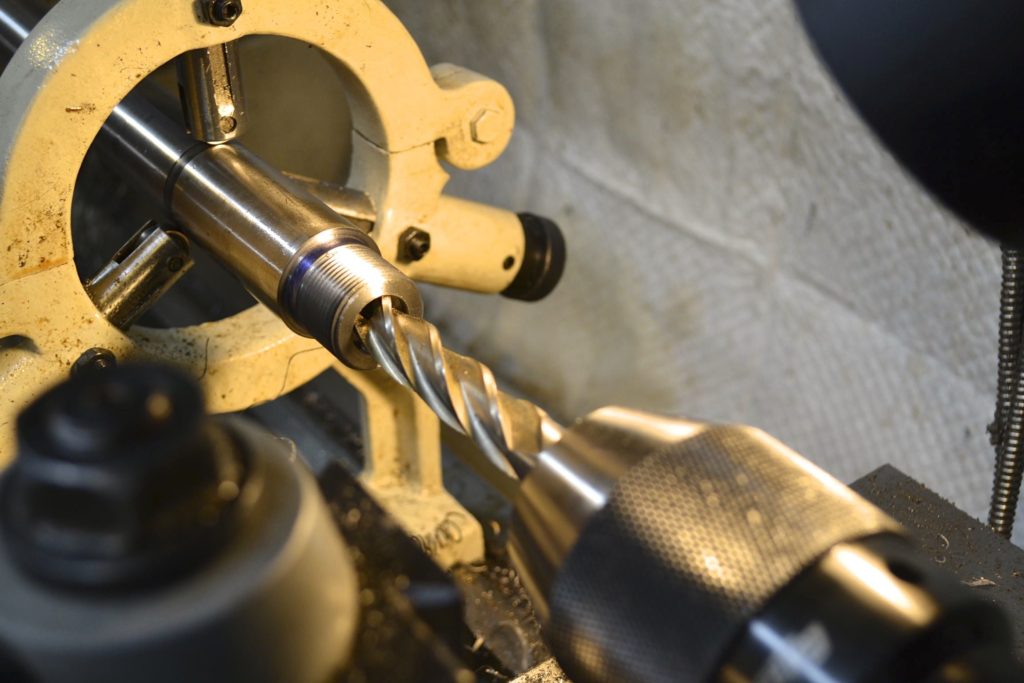
The barrel chamber refers to the part of the barrel nearest the stock of the gun where the ammunition is loaded and fired from. The chamber directly affects the type of ammunition your rifle can shoot, so you will need to decide what you want out of your gun before choosing a barrel chamber.
To make it simple, the most popular style of barrel chambering for an AR-15 is the 5.56x45mm NATO, which provides you the ability to shoot both 5.56mm and .223 caliber bullets.
Hybrid chambers do exist, like the .223 Wylde, which features the 5.56 NATO dimensions and angling but the free bore diameter required for .223 caliber ammunition. This provides extra stability while leaving clearance for both the .223 and 5.56 mm ammunition as well.
Other popular barrel chambers for the AR-15 include the .50 Beowulf, .458 SOCOM, and the 6.5 Grendel.
Barrel Lining
Next, you need to consider the type of lining you’d like for your barrel, or if you even want your barrel lined at all. First, let’s discuss the difference in lined vs. not lined barrel:
Barrel lining is used to coat the inside of the barrel to provide a longer lasting finish and has some effect on the friction between the barrel and the bullet. An unlined barrel may not last as long, but can often provide a smoother surface. This depends on the type of lining.
The most popular type of barrel lining is the chrome lining which is used by many popular manufacturers. This lining can greatly increase the life of your barrel. However, chrome is generally difficult to apply to the inside of the barrel and is almost never applied in a perfectly even coat. Therefore, the discrepancies in the surface of the chrome coating versus the surface of the inside of the barrel can slightly affect the accuracy and precision of the shot. Typically, this is minimal but can show a greater impact on accuracy when shooting long distances, so it should be considered if you are building your weapon to be used primarily at long ranges. Chrome lining can increase the price of the barrel as well.
Another idea is the option of Ferritic Nitrocarburizing, which can go by the name of Melonite, Nitride, or Tennifer. However, this is not really a “lining” and is instead a treatment done to the surface of the metal barrel. Because there is no coating, there is little to no impact on the precision during shooting. However, this treatment will increase the life of your barrel without increasing the price by much at all.
Barrel Profiles/Contours
The contour or profile of your barrel affects your shooting precision as well as the overall weight of your weapon. There are three standard categories for barrel contours. Here’s a quick look at these categories:
Lightweight: A lightweight barrel will lengthen your load when carrying your weapon and is sometimes less expensive than most other barrel profiles. However, lightweight barrels experience a decrease in durability and life expectancy when fired frequently enough to heat up the metal, and they heat up more easily than heavier barrels. This should be miniscule enough that it won’t affect moderate recreational shooting, but it is worth mentioning. Lightweight barrels can be more susceptible to barrel whip, or slight moving of the barrel during a shot, which can decrease accuracy. However, this option may be best for a child simply due to how much it can increase the mobility of the gun.
Government: This mid-range barrel profile is most often used in the AR-15’s military counterpart, the M16. This is because it is lightweight enough to easily carry around while providing the stability to withstand rapid automatic-fire and the heat associated with it. Government, or medium profile barrels, are often pretty accurate and stable enough to provide a precise shot.
Heavy: This type of barrel will last much longer than other standard barrel styles and is not very susceptible to heat-induced damage, even during a constant rapid fire. However, it can significantly increase the weight of the gun, which is not always great for tactical shooting.
For the moderate recreational shooter, light or medium weight barrels will do just fine. Another style you may see is the “fluted” profile, which essentially hollows out certain areas of the barrel to create a surface that helps dissipate heat at a better rate, therefore increasing the guns durability against heat and making the barrel much lighter to carry around.
Barrel Feed Ramps
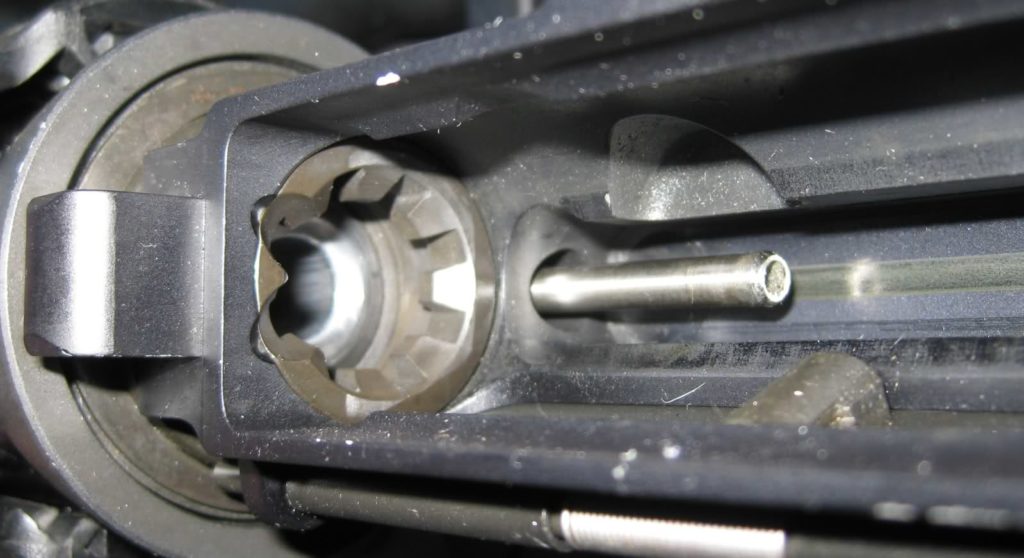
A feed ramp helps to guide the bullet properly into the chamber’s breach. The main consideration when choosing a barrel feed ramp for your AR-15 is whether it is fully compatible with your weapon. The grooves in the feed ramp should fluidly match the grooves in your gun’s receiver. If not, it could cause issues with your gun and decrease shooting accuracy. The best way to do this is to purchase your receiver and barrel feed ramp from the same manufacturer as coexisting parts.
AR-15 Gas Systems
Because the aR-15 is a gas powered weapon, you will also need to lend consideration to the gas system for your building project. There are two styles for your consideration, including the Direct Impingement (DI) and Piston systems. The Piston system is the more modern take on the gas system for the AR-15, while the Direct Impingement system is what you will find in original versions of the weapon.
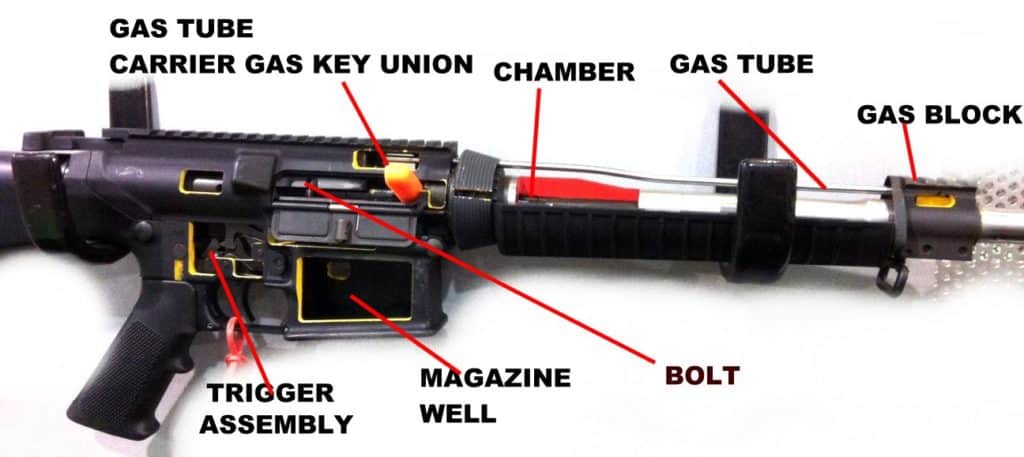
Direct Impingement Systems vs. Piston Systems
The AR-15 is gas powered, meaning it uses compressed gas to begin the force that puts the bullet into motion down the barrel. There are several ways this can happen. In a direct impingement system, the gas moves the barrel from the chamber and pushing it directly back, unlocking the bolt and releasing the firepower from the bullet casing. All in the same motion, the force of the gas pushes the empty casing from the gun and loads the chamber with a new cartridge. Typically, in a DI system, the gas is released pretty close to the chamber, so you can expect the chamber and the receiver to get really hot during frequent fire.
In a Piston system, the same actions occur, except that the gas initially moves a piston inside the gun, which results in the same steps to follow. The piston is further from the chamber though and creates much less heat than the alternative DI system, which can sometimes result in a better lifespan for all surrounding parts. The main difference is that the piston vents away the used gas, keeping your gun cleaner than a DI system, and is typically more reliable due to the condensed movement of the gas. However, the piston system is typically more costly and difficult to repair and also is quite a bit heavier than the typical DI system.
The piston system is typically preferred by those who use their gun in unfavorable conditions like rain or intense heat because it provides a more consistent shot even during a range of environmental factors. Unless you plan on consistently shooting in harsh environments, though, a DI system should be plenty.
Direct Impingement Gas System Lengths
The length of the gas system will affect things like the amount of pressure and gas dissipation as well as the length of area available for the handguard. Typically, for standard AR-15’s, the average size of DI gas systems is the rifle length gas system. Longer gas systems often result in a smoother shooting experience because the gas has more distance to “settle” before returning to the chamber. However, this can also be affected by other factors, like the port size, or buffers.
The gas system length refers to the distance of the gas hole, which is usually located in the front base sight, therefore longer gas systems leave more handguard space. There are four different main types of gas system lengths. These four include:
Pistol Length Gas System: This gas system works best for guns with barrels that are less than ten inches long and when the gas block is four inches from the port.
Carbine Length Gas System: This works well when the barrel of the gun is between ten and eighteen inches long and the gas block is around 7 inches from the port.
Mid-Length Gas System: You should use a mid-length gas system when the barrel of the gun is between fourteen and twenty inches long and the gas block is somewhere near 9 inches from the port.
Rifle Length Gas System: The rifle length gas system works well on guns with a barrel longer than twenty inches where the gas block is twelve inches from the port.
Gas Blocks
For standard FSB (front sight base) style barrels, the gas block is built into the front sight base, which is where the gas is released to once it is forced down the barrel. This gas is redirected back towards the receiver. This is important for consistent gas pressure. Typically, the best way to go is to use a FSB barrel with the gas block already included in the sights, but there are other options.
If you want to opt for a free-floating barrel, you may need an aftermarket low-profile gas block. Some of these gas blocks are also adjustable, meaning you can fine-tune your weapon to redirect the exact amount of gas necessary to shoot your weapon with high accuracy and precision. This is a great feature because the amount of gas needed depends on multiple factors. For instance, the buffer weight can affect the amount of gas needed for the gun to properly cycle, as can the type of ammunition used.
Too much gas flow can cause extra wear and tear on the rifle while shooting as well as excessive recoil, while too little gas flow can result in a jammed rifle or make the rifle have trouble cycling.
Hand Guards
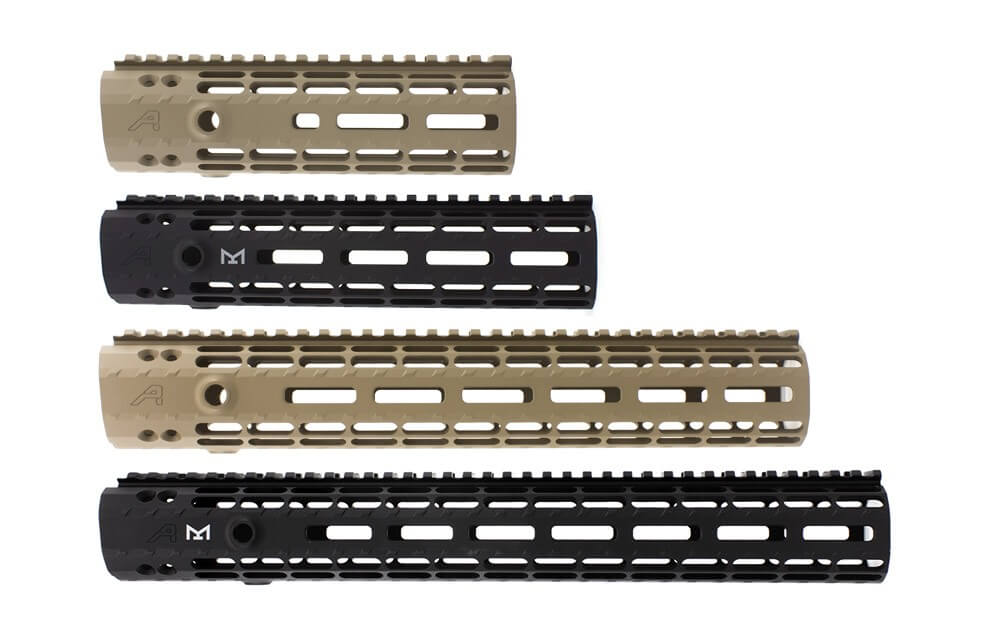
A FSB style barrel basically forces you to use a non-free-floating handguard, like a drop-in handguard, which is typically fine for moderate recreational shooting. This is the classic style handguard you see on the original versions of the AR-15 and is a “two-piece” style guard. Typically the stock is designed for a drop-in handguard and it has a simple spring-loaded fixture that makes it easy to install and remove to change your hand guard. Typically this style of handguard is much less expensive than any alternative.
There are two popular types of drop-in handguards, including the polymer drop-in style and the railed drop-in handguard. The polymer drop-in handguard is a 2-piece handguard made from a piece of polymer that is internally coated with a heat-shielding material. This style of handguard is durable and resists damage due to heat. Polymer is not very heavy and is easy to maneuver. You can find polymer handguard upgrades to further customize this style of the drop-in handguard.
Drop-in railed handguards, or drop-in rails, are generally made from aluminum, meaning they can easily heat up. These styles include rails that make it easy to mount accessories to your gun. The “quad-rail” handguard has four rails that span the length of the guard and allow you to attach virtually anything you may need. These styles may be a bit pricier, but they look pretty cool.
Another style of handguard is the free-floating handguard, which is more customizable and usually provides better accuracy when shooting. Because the handguard doesn’t make contact with the barrel of your gun, you gain precision while aiming and firing. This is especially important when using a bipod or grips. The “free-floating” style handguard allows the gun to essentially stabilize itself and not be impacted by its contact with the guard and bipod or grips. This will prevent your bipod from warping your barrel, too.
There is two style of free-floating handguards, including the railed free-floating handguard and the non-railed free-floating handguard, which is more often referred to as “free float tubes.” The railed style in addition to a low profile gas block allows you to attach virtually and add-on or accessory to your gun.
Bolt Carrier Group (BCG)
The bolt and the bolt carrier together make up the bolt carrier group or BCG. This is basically where the magic happens. When you move the charging handle on your gun, the BCG is moved as well. This mechanism strips a round from your magazine and loads it into the chamber of the weapon. Then, as you press on the trigger, the hammer makes contact with the firing pin, which primes the cartridge and ignites the flammables, which then send your bullet into play.
There are two styles including the fully automatic BCG and the semi-automatic BCG. Many manufacturers include a fully automatic BCG, but this does not automatically make your AR-15 a fully-automatic weapon. The inclusion of the fully automatic BCG is due to its heavier mass, which slows down your guns cycling rate. The fully automatic version also has a guard to keep the firing pin from contacting the hammer while cocking the weapon. Either version will work fine, especially for moderate recreational shooters.
BCG Coatings
You can purchase your bolt carrier group with a coating, but this is more modern technology and is not required. The benefits of the coating on your BCG is that they are often easier to clean and require less lubrication to function correctly. There are several different styles of BCG coatings, including black nitride, hard chrome, nickel boron, and titanium nitride. This is really only necessary if you run your gun often enough that it stays consistently dirty, in which case you may benefit from the easy cleaning.
Buffer Tube
When you cock or fire your weapon, the BCG is moved and contacts the buffer spring located inside the buffer tube. This spring serves an important purpose in pushing the bolt carrier forwards to strip a round from your magazine. It may not sound super exciting, but this little buffer tube is a necessary component and your gun won’t function at all without it.
There are a few different types of buffer tubes on the market. Here are the ones you will see most often:
- Carbine Buffer: This type of buffer has a steel construction that is made up of three weights and usually weighs around 3 ounces total.
- Rifle Buffer: This buffer is heavier and contains five weights made of steel, as well as a steel-made spacer. It weighs around 5 ounces.
- H Buffer: H buffer stands for “Heavy” buffer and is made from three different weights, two of which are steel and the other is tungsten. An H buffer weighs around 3.8 ounces.
- H2 Buffer: The H2 buffer is made just like the H buffer, but weighs somewhere near 4.7 ounces.
- H3 Buffer: Again, this has almost the same design as the H and H2 buffers, but has a total weight around 5.6 ounces and contains three tungsten weights instead.
However, these are not the only styles. For choosing other buffer tubes, let’s look at the different materials used to make them:
- Steel: Steel is great because it is durable and can last a long time without being replaced. It is particularly heavy, so it is used to make heavier buffer tubes.
- Lead: Lead is the second heaviest material commonly used in making buffer tubes, so it is great if you need a heavy duty buffer tube.
- Tungsten: This is the heaviest common material, typically used to make buffers weighting around 0.7 pounds.
- Aluminum: Aluminum is notoriously light and can create a buffer weighing less than 0.1 pounds per cubic inch. However, aluminum is not very durable and may not last as long as other options.
Triggers
Here’s a detail that may get overlooked, but really, the trigger design is an equally important factor in how your gun will perform and how comfortable it will feel for you. Usually, you should leave trigger work to the professionals, but an AR-15 is so easy to build and customize, and installing the trigger is no different. Here are a few options for you to consider:
- Sports Specific Triggers: These can be light and have a one stage pull, as well as a short reset, which makes them great for shorter target ranges.
- Combat Style Trigger: These are typically non-adjustable and durable, as well as reliable.
- Two Stage Match Triggers: This is great for High Power shooting or long range targets. It can also be used well for medium range targets, too.
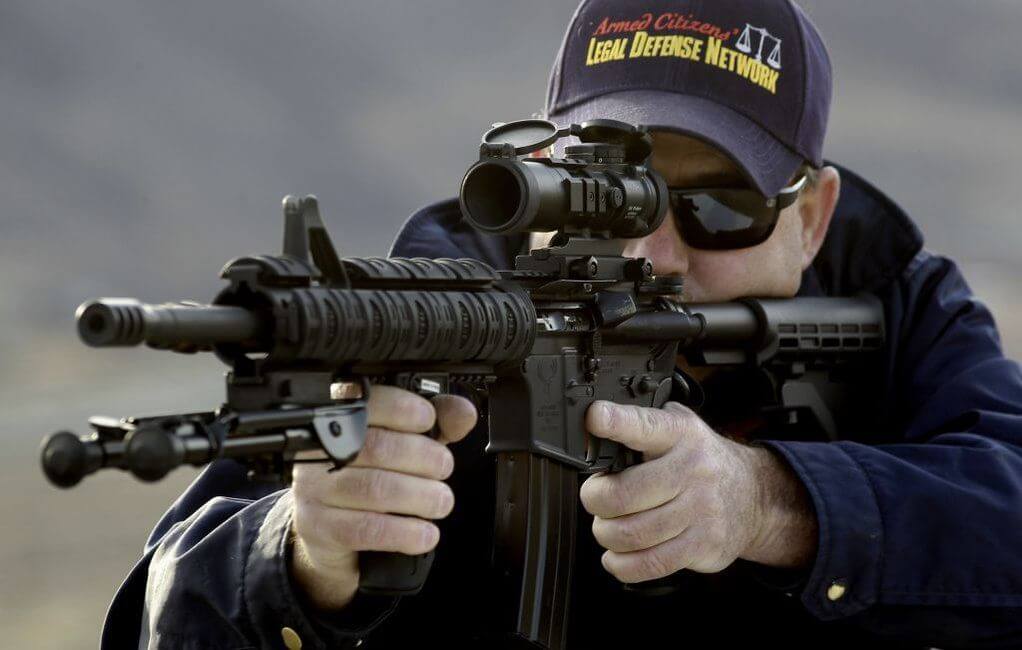
AR-15 Optics and Sights
Back to the fun stuff. Choosing the optics for your weapon will both change its look dramatically and determine the amount of vision you have on your target as well as your shooting style while handling your new weapon. There are plenty of different styles of sights and optics for your AR-15, like laser sights or scopes, so you can choose one, or several and switch them out as you please. Here are some ideas for you to look at:
- Reflex/Red Dot Sights: Reflex sights have a reflective lens with a mirror coating which helps project the image of the target back towards the eye. Red dot sights fall into the reflex sight category because they have the same partially-mirrored lense. Some reflex lenses work by utilizing the ambient light to provide accelerated vision even in low-light situations. There are two styles of reflex sights, including the tubular style (like a scope) or the “heads-up” style, which simply features a double layer lens, similar to the size and shape of one square eyeglass lens, which is mounted on top of the gun. This style mount is less bulky and heavy than tubular sights.
- Holographic Sights: Holographic sights function with the use of a laser, which illuminates an image of the target between two lenses and makes it appear at a virtual 50 feet away. This style of sight is only available as a “heads-up” style sight, and there is no tubular version available.
You will also have the choice between a fixed power scope and a variable scope. This means you can change the magnification level and the focus of a variable scope, which is an advantage in itself. However, fixed power scopes do not require as many small parts, and are generally a sturdier, longer lasting option.
Typically, choosing sights for your weapon all depends on how you want to use it. For long range hunting or target shooting, generally, a scope is your best option. For tactical shooting or close range targets, holographic sight or red dot sights are often best.

Buying Part Kits
You can purchase part kits through many manufacturers which include a collection of parts to help build your weapon. This includes part kits for upper receivers or lower receiver. You can also find part kits that include almost everything you need to build your weapon. This can be incredibly convenient if you want the entire upper or lower receiver to be made by the same manufacturer, or if you find a kit in which every part meets your need. In some cases, though, you will not be able to get as much customization using part kits, and will instead need to purchase parts individually in order to get exactly what you are looking for in your weapon.
Another benefit to consider when choosing between individual parts and part kits is that the kit will often save you some money as opposed to buying each individual part, although some manufacturers may do “bulk purchase” discounts, which may make it an equally good deal. Of course, this again means buying all or most of your parts from the same manufacturer, which may not be ideal for every gun owner.
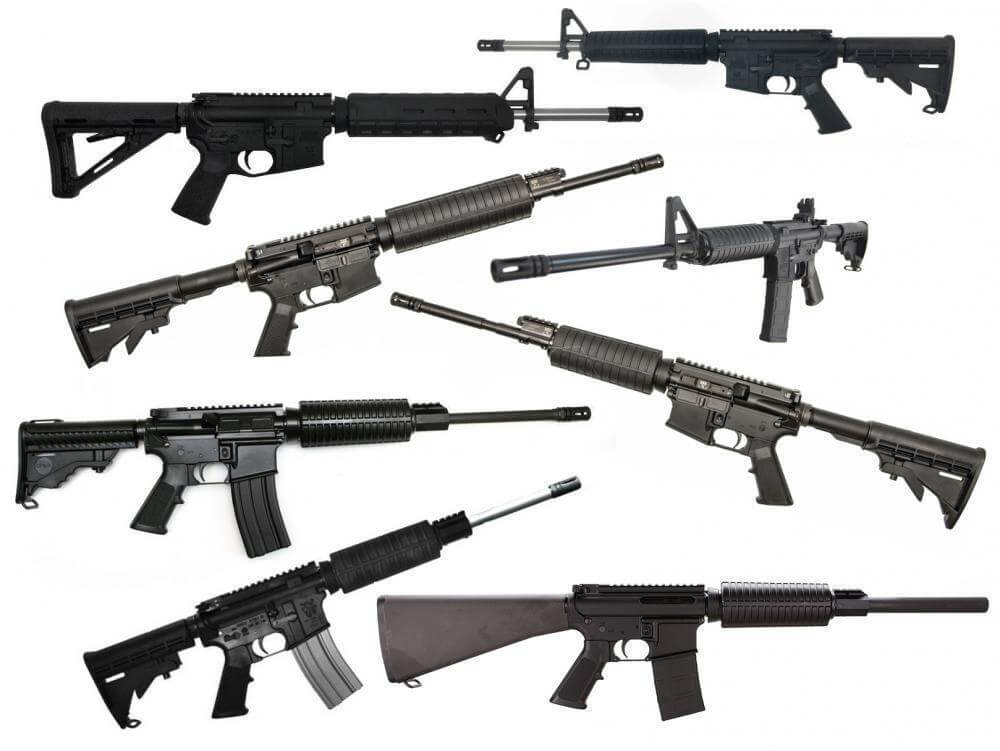
Rhyme and Reason for Different AR-15 Styles
When you build your own AR-15, you can optimize it for your intended purpose or simply just to make an aesthetic weapon. In some cases, you can buy AR-15’s with specific optimizations depending on your intended use, but typically, for anything specific, you will need to do it yourself. Let’s look a few style and purposed for different styles of AR-15 builds:
- M4-gery/Tactical Build: “M4-gery” refers to an AR-15 style that replicates an M4 build as close as legally possible. While opinions of what makes an Ar-15 and M4-gery vary, there are a few modifications that are often done. The M4 carries a standard 14.5” barrel, so typically these style AR-15’s have a 16” barrel, which is the closest legal length. The M4 typically carries the RAS or SIR handguards, which will fit well on the AR-15. Other inclusions may be a mid-length gas system and low profile gas blocks. Some people opt to use extended feed ramps as well. Others say that the gun must be produced by Colt to be a true M4-gery, while others say it doesn’t matter what brand, it only has to look the part. Many people opt for this style based solely on looks, and they do look pretty cool. Usually, this style of weapon can be used for tactical encounters as well.
- Rodents/Precision Shooting: This AR-15 build usually features a lengthy, heavy profile barrel for extra stability in long shots. They will also feature a free-floating handguard and heavy stock area, as well as some type of precision enhanced optical attachment. This is built for precision shooting over long ranges and hunting small animals, like raccoon or rabbit.
- Competition Shooting/3-Gun: AR-15’s are often modified to be used in the “rifle” portion of a 3-gun competition. Some variations include installing a rigid, single stage trigger, adjustable gas block, and an ambidextrous safety switch for shooting with your non-dominant hand. Many other modifications can be made, it just depends on what features you need most for competition shooting.
- AR-15 Pistols: This style of the AR-15 build will not have an actual buttstock and features a barrel shorter than 16 inches, which is typically referred to as a short barrel rifle. AR-15 pistols are lighter and easier to handle than the standard rifle version, but the shortened barrel length results in velocity loss and sometimes the shooting style can affect accuracy. You will also need to register the weapon differently and hold a special stamp for weapons with barrels under 16 inches.
- Featureless Build: The idea behind a featureless build on your AR-15 is to avoid having to register it as an “assault weapon,” which makes it possible to own one even as a resident of CA of NY. Featureless builds will not contain any of the following: thumbhole stock, pistol grip, flare or grenade launcher, telescoping/folding stock, or a flash hider. They will function with detachable magazines. There are a few other moderations that are made to featureless build guns, but you should check with state laws to see what is legal and what should be avoided.
How and Where to Buy AR-15 Parts and Completed Rifles
There are a large variety of manufacturers out there that market their products as the best of the best, and it can be hard to know who you can really trust. Whether you plan to build or buy you will need to find a trusted manufacturer, since you will need to either purchase the gun or purchase the parts. In the case that you are building your AR-15, you may purchase parts from a variety of manufacturers. This is fine, as most parts will work together seamlessly, but you should always be careful that you are purchasing quality parts from a reputable manufacturer. After all, this is a firearm you are building, so cheap, unreliable parts could get really ugly really fast. Even if your weapon doesn’t misfire or spontaneously combust, it is nice to have confidence in its reliability, especially in defensive situations where your life is at stake. It’s these reasons and more that we cannot stress this point enough: Buy your AR-15 or AR-15 parts from a TRUSTED manufacturer.
There are many reputable companies out there, and there is no way we could have written an exhaustive list, but here are a few manufacturers to take a look at:
Best Manufacturers for AR-15’s
- Colt: Colt is the original mass manufacturer and continues to be one of the absolute best even today. Colt’s AR-15 rifles are the closest exact replica of the M4 and feature every single possible legal feature of the M4. They advertise their AR-15 rifles as MIL-SPEC, and it’s entirely true. Despite making some of the best AR-15’s money can buy, they are actually moderately prices, and many models start at prices under $1,000.
- BCM: This rifle company is veteran-owned and has only been around since 2005. However, in their short lifespan, they have dedicated their force to creating reliable equipment. Their AR-15 barrels are all M197 High-pressure tested and Magnetic Particle inspected to ensure that they are durable and reliable for users. The rifles already include stock M4 feed ramps and an anodized receiver. Their rifles start at prices just over $1,000.
- Daniel Defense: This company is one of the only that produces cold hammer-forged barrels. You will find Daniel Defense AR-15 is multiple varieties, including pistols, carbine, mid-length, and rifle-length gas systems. They make a variety of in-house parts, too, including rails, flash suppressors, sights, and stocks. They are a bit more expensive than some other top brands, starting at around $1500.
- LWRC International: This company has dedicated plenty of time and hard work to developing and perfecting a short-stroke piston system for the AR-15. This piston system is showcased in their LWRC rifle, which features a MIL-SPEC sized buffer tube and an anodized coating. Their barrels are crafted from 41V5 steel alloy which is treated with NiCorr to avoid the need for chrome lining. The BCG is coated with Nickel Boron to create a durable mechanism. You are looking at rifles starting at over $1,600.
- Noveske: This company was started by an Army veteran and includes an extra durable barrel that is coated with a thick layer of chrome. In fact, their AR hard-chambered barrels exceed MIL-SPEC standards with a stainless steel hardness rating of 416. For a steel barrel that won’t wear down with use, this is where to look.
Some other manufacturers to consider for a quality weapon include:
The prices for completed AR-15’s will vary greatly based on features and manufacturer. Some of the top quality guns can easily cost upwards of $1k, while you can get lower quality versions for around $300. You can find completed rifles with top-notch accessories and add-ons for well over $2,000.
Price does not necessarily determine the quality of the gun, but you should consider that established and well-trusted manufacturers will probably charge more, and can, in turn, offer more durable materials and more precise quality control. You don’t necessarily have to shell out an arm and a leg, but be wary of the cheaper guns. If it seems too good to be true, it probably is.
Buying a Completed AR-15
If you want to avoid the hassle (if you can call it that) of building your own AR-15, or if you’ve built one before and simply want another completed model to add to your collection, you should still seek out the best manufacturers before purchasing a weapon. Completed models vary greatly, just like all of the parts and add-ons do, so take your time shopping around. You never know what cool feature or add-on you will find from one manufacturer to the next. Also, remember that just because you buy a completed model with one set up doesn’t mean you can modify and customize the rifle to fit your wants and needs. A completed rifle can be altered just the same as you can build a rifle at home. (Be sure to see what parts are integrated, like barrels with non-detachable extensions, etc, because some parts may not be removable.)
If you’re wondering what our take is on some of the better fully complete rifles on the market today, here are some of our favorites:
The AR-15 is Perfect for Anything
The AR-15 is America’s favorite semi-automatic rifle for a reason, and it’s modular, easily customized build makes it a favorite modern sports rifle. The gun is great all around, whether you plan to use it for sports shooting, home defense, tactical deployments, competition shooting, or hunting various game. The best part is that you can customize your AR-15 to be virtually anything you want it to be, giving you the variety of a lightweight, easy shooter or a heavy-duty rifle that packs a punch.
There are hundreds of manufacturers and even more parts out there to explore, so there’s a good chance your new AR-15 will quickly become your weapon of choice. There is a reason that it is the weapon of choice of much military personnel and is one of the main rifles used to defend the great country of America. We hope our guide has given you everything you need to know about this spectacular rifle and helped you find the best one for you.
